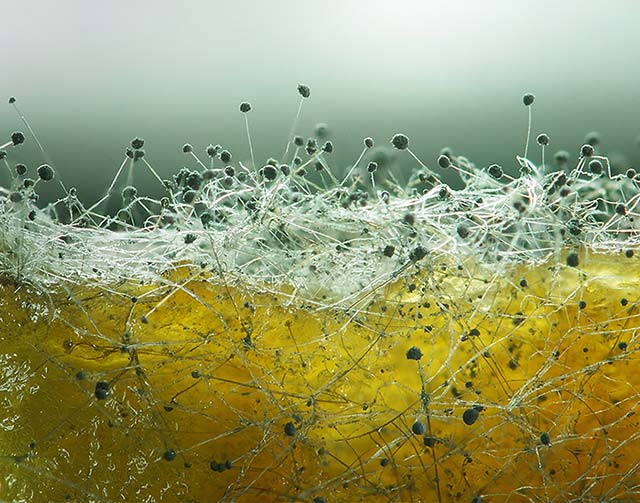
Mold and Mold Testing
Dandelions and Brussels sprouts? No, it is mold under magnification. If water gets to the wood in your walls, mold growth is inevitable.
What is Mold?
Here we will cover mold and mold testing. Mold is a type of multicellular fungus that is commonly found inside RV walls with a wood substrate that have experienced even the most minor of leaks. But mold isn’t guaranteed; it has some key conditions it wants met before it’ll grow. The essentials for mold growth include moisture (or water), oxygen, darkness, warmth, and food.
Read below for much more important information about mold, why Azdel Onboard® composite panels eliminate this problem and, if you haven’t seen them yet, check out our related pages about two other major benefits of our composite material: Water Resistance and Low VOCs.

Mold Growth Requirements
When excess moisture isn’t readily available, mold will pull what it needs from the air. Mold does not like certain types of light, such as UV, so it thrives in darkness. And while it can grow in temperatures between 40° and 100° Fahrenheit, its sweet spot, like that of humans, is about 60° to 85°. Molds can feast on a variety of materials and other substances, but wood fills the bill as well as any.
Even if these needs are met, mold spores first need to exist for growth to begin. But that’s usually not an issue, as mold spores are present virtually everywhere — floating in the air outside, inside our homes, inside our RVs, on plants and a variety of other surfaces. However, without a preferred surface on which to grow that also offers the other ideal conditions, the spores will simply die.
More About Mold
There are over 100,000 species of molds and not all are harmful. Some even offer benefits such as the natural breakdown of biodegradable goods. On the other hand, many are very destructive to materials. Unlike mildew, molds can penetrate the surface of its host, causing additional damage.
Most molds generally fit into one of three categories: allergenic, pathogenic and toxigenic. While an allergenic mold might trigger an allergy, it usually doesn’t cause an actual illness. People who deal with deficiencies in their immune system can experience problems from pathogenic molds, including infections. And, as you might have guessed, toxigenic molds are nasty. They are typically toxic to anyone who comes in contact with their spores.

Mold Growth in Action
This is a time-lapse video of one of our water soak tests as explained on our Water & Moisture Resistance page. It covers a span of two months. The video offers a side-by-side comparison – or contrast, actually – of lauan plywood and Azdel Onboard composite samples. Mold appeared on the wood within a few days, but it never did grow on the Azdel sample – and it won’t. In similar tests, mold typically appears on wood in five to seven days.
Consider also that as the conditions in the jar were less favorable as oxygen depleted, the mold growth actually slowed. But imagine unrestricted growth with a nearly endless supply of water, wood and oxygen in real world conditions. That is scary – and gross – and expensive to fix.
See the before and after shots near the end. Which do you want in your RV?
Why is Azdel Composite Unaffected by Mold?
In a third party mold test, we were surprised to learn that mold spores were present even on our material. But this turned out to be a good thing. You see, their presence alone isn’t enough for concern. As mentioned above, not only are mold spores found virtually anywhere, but mold growth has criteria for success. If one or more of those is missing, mold will simply not grow. That is the case with Azdel’s composite. Mold does not see our fiberglass and polypropylene blend as food. Thus, it was proven that even when the spores exist, mold still will not grow on Azdel’s composite. Additionally, with the porous nature of Azdel’s material, is does not retain water like wood does. This all helps extend the life of your RV.